|
The World's Finest Presents 
THE WORLD'S FINEST MAIN PAGE · SITE SPECIALS · EDITORIALS · FORUM
Everybody Loves a Clown: Joker and Harley Quinn
The Possible Return of Batman: The Animated Series, Part 7
By Joseph Davis
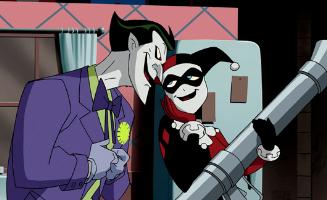
Many readers must have noticed that I’ve spent three essays sizing up Batman's Rogues' Gallery, looking at every possible candidate for the role of antagonist in my anticipatory, now-fictional BTAS reboot. I've scrutinized everyone from Two-Face to the Polka-Dot Man, but there are two major villains that I've yet to discuss. You know who they are. I've said previously that they both deserve special consideration, as 1) both characters are currently at the height of their popularity and 2) in many ways, they've evolved beyond Batman and are now independent characters who are capable of being in their own stories without him. However, while this statement is true, there are also unique several factors that inhibit them as well. Still, I believe that both characters should feature significantly into any BTAS reboot, fictional or otherwise, and they could provide at least one solid story arc (if not more), so let's discuss the Joker and Harley Quinn, as well as how they would fit into my proposal.
(Shameless plug: one of the things I did during my hiatus from the DCAU was to be a contributing writer to a podcast called The Final Edition Radio Hour and one of the sketches I wrote was called "The Ridiculous Overexposure of One Harley Quinn," which touched upon a lot of stuff that I'll be expanding on in this essay. To hear it, click here. The podcast is sadly defunct, but we have a pretty impressive selection of material on SoundCloud, though some of it is a little bawdy.)
Something Bad Happened to a Clown—The Joker
"All it takes is one bad day to reduce the sanest man alive to lunacy. That's how far the world is from where I am: just one bad day. You had a bad day once, am I right? I know I am. I can tell. You had a bad day, and everything changed—why else would you dress up like a flying rat? You had a bad day, and it drove you a crazy as everybody else…only you won't admit it! You have to keep pretending that live makes sense; that there's some point to all this struggling! God, you make me want to puke. […] It's all a joke! Everything anybody's ever valued or struggled for…it's all a monstrous, demented gag! So why can't you see the funny side? Why aren't you laughing?"
—The Joker (to Batman) in Batman: The Killing Joke
"Know this, my sweet: the death of Batman must be nothing less than a masterpiece. The triumph of my sheer comic genius over his ridiculous mask and gadgets!"
—The Joker (to Harley Quinn) in The Batman Adventures: Mad Love
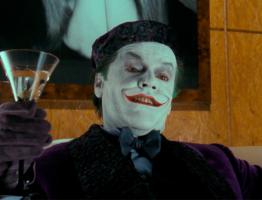 
While he may suffer the indignity of only being the second scariest clown in fiction—I'd give that trophy to Pennywise from Stephen King's IT—the Joker can rest assured that he one of the first modern comic book supervillains, as well as one of the most popular. Now, there are other locations that have done a much better job of detailing the character's active history—Cracked did a wonderful five-part series of essays detailingthat, for example—so instead of rehashing already tread upon ground here I wanted to touch on a few key points, including my theory that, in recent years, the Joker has succeeded in besting Batman in terms of popularity.
While Batman is one of the most popular comic book characters right now—and has been for decades—in many ways the Joker has become more so. Consider: in the promotion for 1989's Batman, Joker actor Jack Nicholson received top billing over Batman actor Michael Keaton. The villain actually got top billing over the hero. And, as for the Clown Prince's other major cinematic appearances, he has—for all intents and purposes—won two Academy Awards: Heath Ledger won Best Supporting Actor in the 2008 for his portrayal of the Joker in the film The Dark Knight, and Joaquin Phoenix won Best Actor for his portrayal in the 2019 film Joker…a film that didn't even have Batman in it. Even considering Jared Leto's turn in 2016's controversial Suicide Squad, that's an impressive feat.
(Keep in mind that genre films don't normally win the big Oscars—they settle for Visual Effects, Costume Design, and Makeup awards. Consider it a prejudice the Academy has against "popular" movies, much like how academics don't consider genre fiction the same as literary fiction. That's why it was such a shock when The Lord of the Rings: The Return of the King won Best Picture in 2004. It simply didn't happen. Anyway, in this system two people who played the Joker in comic book movies won Oscars.)
And it continues: as of this writing, it has been confirmed that Lady Gaga will join Joaquin Phoenix as Harley Quinn in a now-musical sequel to Joker. Meanwhile, following the release of 2022's The Batman—despite its strong casting with Colin Farrell as the Penguin, Zoë Kravitz as Catwoman, and Paul Dano as the Riddler—all anyone seemed to talk about was the deleted scene featuring a cameo by Irish actor Barry Keoghan as the Joker. If the current trend continues, the Joker could be up for a third Academy Award (as well as one for Harley Quinn). Batman may be the marquee name, but it's the Joker that the crowds are really interested in.
One of the reasons why the Joker is so popular is because, unlike Batman and any other superhero character you can think of, the Joker is a character that can be interpreted and reinterpreted with ease. He's never the same—whether its Nicholson's gangster artiste, or Ledger's urban terrorist, or Phoenix's dancing Travis Bickle, or Mark Hamill's combination of all three (and then some), the Joker can be anything…just so long as the character has the trademark purple suit, green hair, and white greasepaint. This is helped due to the fact that the Joker has no official identity, background, or name. Sure, he may be sometimes identified as Jack Napier or Arthur Fleck, but he will forever officially be "name unknown." The Joker is not a person—he's the boogeyman.
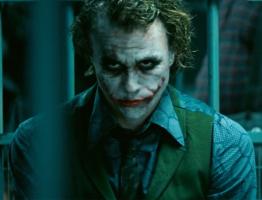 
Where does that leave us in terms of my fictional BTAS reboot? Well, it leaves us with a lot of expectations, as well as some concerns. We've had the benefit of Mark Hamill's Joker for thirty years, but what could the Clown Prince of Crime do that would be worthy of a return engagement? After all, as writer Paul Dini has wryly noted, "[t]o him, if a crime isn't worth pulling off with panache, it's not worth doing at all." Also, in addition to these expectations, there is also the sad fact that Mark Hamill can't quite do the voice as he used to. If you compare his performances—say, material from BTAS and Batman Beyond to his later work in the video games and linkJustice League Action—you'll notice that the voice has become coarser over time, and his trademark manic laughter has become subdued, even absent (this puts his previous attempt to retire from doing the voice in a new perspective). And, of course, there's other concerns, which directly relate to his relationship with America's favorite crazy ex-girlfriend…
The Tears of a Clown—Harley Quinn
"In her own way, Alfred, Harley Quinn's as crazy as the Joker. Her playful exterior hides an obsessive and dangerous mind. […] Even from the beginning…Harley Quinn was no angel."
—Batman (to Alfred Pennyworth) in The Batman Adventures: Mad Love
Question: what do you get when you take an original character from a popular animated series and apply her to the mainstream comic books? Answer: you get Harley Quinn, a character that—along with Marvel Comics' Deadpool—is the most popular new comic book character created in the past thirty years. Making her debut as a henchperson for one episode, the character (largely based on co-creator Paul Dini's friend Arleen Sorkin) quickly became the breakout star of the series. Said Paul Dini in a 1993 interview with Animato! Magazine:
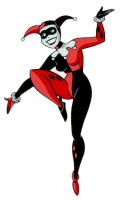 Harley had been created as a secondary character for a show called ‘Joker's Favor.' I needed a girl to wheel in a cake in one scene. […] What if we do a twist, harkening back to the Sixties, where the villain always had a girl with him? The Joker is a pretty colorful personality. He probably would have a girl of two around. A couple of girls who are into him the way a girl would be into a rock star, leading that kind of exciting life. Harley had been created as a secondary character for a show called ‘Joker's Favor.' I needed a girl to wheel in a cake in one scene. […] What if we do a twist, harkening back to the Sixties, where the villain always had a girl with him? The Joker is a pretty colorful personality. He probably would have a girl of two around. A couple of girls who are into him the way a girl would be into a rock star, leading that kind of exciting life.
I began working on the character a little bit. I decided to make her kind of funny. Kind of like a clown in her own right. Somebody whom the Joker might get upset with if she got a better laugh than he did. That started to add a little twisted chemistry to what this character was to become. I started thinking of it as a sort of Punch-and-Judy sort of relationship.
I was sort of stuck for a name, so I started to rattle off a couple of names in my head. Somehow, Harley Quinn stuck because I was thinking of clowns, clown-like imagery, and carnivals. Then I took Harlequin and split it in two. […] She's a good sidekick for the Joker, but she's evolved into a player on her own. She's evolved into this manic, happy-go-lucky screwball type, who maybe, deep down, wants to do well. Or, at least wants to do well by herself. But she doesn't care how she accomplished that.
However, with this popularity came a host of problems, such as the impact that this wacky girl sidekick would have on the chaotic force that is the Joker. Bruce Timm had this to say in Modern Masters, Vol. 3: Bruce Timm (July 2004):
When Paul [Dini] first mentioned the idea to me, I thought, ‘Okay, that's kind of clever.' We put her in ‘Joker's Favor,' but it wasn't until we got the footage back from overseas and we saw her on the screen that everyone instantly fell in love with her. It was a combination of the personality and the voice—Arleen's voice—and the visual. It was ‘Wow! She's a doll.' She's a great character; you just realize we caught lightning in a bottle. As much as I didn't want to keep using her, because I had this gut feeling…We kept trying to make the Joker scary, and scary, and scary, and by having his wacky girlfriend there it brings out his goofier side. I was really concerned about that, but we all loved the character, so Paul kept sticking her in every Joker show. We would read it and go, ‘I don't know, maybe we're overusing Harley. Joker's losing his edge.' Sure enough, I think that is kind of the case.
Another issue the creative team ran into was regarding her characterization. Was she a villain, or was she something more sympathetic? In her earlier appearances ("Joker's Favor," "Almost Got ‘Im," and "The Laughing Fish") she was simply another bad guy. This changed in "Harley and Ivy" (first aired January 18, 1993), where we first started seeing her as another victim of the Joker. Said Bruce Timm in a 1993 interview with Animato! Magazine:
 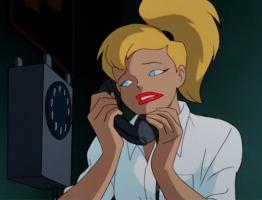
I'm kind of sad that we're turning her into such a likeable character because I liked the early evil Harley. There was something really neat about her being so cute and evil at the same time. There was all that stuff in ‘The Laughing Fish,' where the Joker is talking about feeding Bullock to the shark, and she's just so excited about it. She's really bloodthirsty and evil but, at the same time, she's charming and appealing.
[‘Harley and Ivy'] was the clincher show in terms of her development. I think it's because you see her with that ponytail. It softens her character a lot. It's really hard to think of her as being evil when she looks like Betty from the Betty and Veronica comics. That really changed how we started thinking about Harley.
Added initial voice actor Arleen Sorkin, from a 1995 interview with Comics Scene, "I see Harley as a girl who wants to do the right thing, but it's just not within her control. She wants to be a good girl, but it's so much more her to be a bad one. I think she's popular because of her vulnerability." And, speaking of that, there's also the issue of the source of that vulnerability, specifically her abusive relationship with the Joker.
Now, in terms of said abuse, we've seen examples of verbal abuse ("Harley and Ivy," The World's Finest), physical abuse ("Harley and Ivy," "The Man Who Killed Batman," "Wild Cards"), and emotional abuse ("Harliquinade," Mad Love). In retrospect, writer Paul Dini sees the parallel between Joker and Harley and similar, real-world relationships in a 1997 interview with Animation Arena:
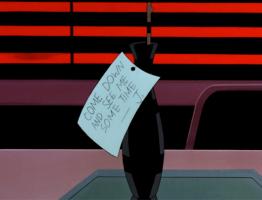 
[Harley] was somebody who was out to use these criminals as a way of writing a book about them to make herself famous. Then she wound up letting her guard down, and the Joker was able to manipulate her the way an abusive parent would manipulate a child—by withholding love, you can get a person to do whatever you want for them. I've seen that happen, time and time again, in relationships, where either guys are led around the nose by women whom they shouldn't be with, or guys take advantage of women. It's like a rock-star mentality. For all his villainy and his insanity, the Joker has this glamorous element to him, which is sort of attractive. I see guys in rock bands who have these gorgeous girls running around, and the guys treat them like dirt because it keeps [the girls] loyal, the girls are attracted to them and the excitement, and the guy knows that and plays them like a cheap fiddle. I think that's a very human thing, and when you put it in a cartoon, as long as you touch on it and not really harp on it, it really plays [well] with the audience.
But even that acknowledgement of the reality of their relationship hit Dini pretty hard upon viewing "The Man Who Killed Batman," where the Joker visually struck her during a robbery (as recounted in Animato!; this episode first aired February 1, 1993, a few weeks after the first airing of "Harley and Ivy"):
I wrote [‘The Man Who Killed Batman'] and didn't have any problems with it at all. It was boarded and Bruce directed the episode, and I didn't have any problems with it at all, but once it came back, and I saw it on film, I had a weird feeling. He'd shoved her around before and done little things to her before, but this was real violence. And I was thinking, ‘I don't want to do that anymore.'
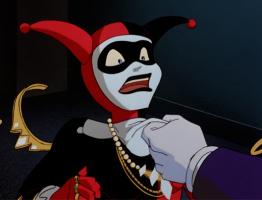 
Perhaps it was seeing his friend Arleen Sorkin (as Harley) thrown across the room by the Joker, but Dini felt empathy for the character her created. And he wasn't alone—watching these episodes when I was 15, I remember being affected by the violence as well. I wanted love and safety for Harley, and I didn't want her hurt. I suspect that this is where Dini pulled back a bit on the Joker's characterization (much to Timm's chagrin), aside from intentionally dark episodes, like their eventual adaptation of "Mad Love."
Of course, in the realm of the DCAU, it's possible that some of this pulling back could be from more than just the writer's room, as the Joker may have unwillingly made himself vulnerable as well. In Gotham City Sirens #5 (written by Dini; December 2009), Harley's then-just-a-friend Poison Ivy had this to say about her pairing with the Joker:
I know something about human hearts—I've spent my life manipulating them. I can tell when there's a real spark there, however small. Joker may have originally thought of you as a willing patsy, but eventually he let you in. Whether he meant to or not, he shared with you things he'd never tell another living soul.
This statement is something that voice actor Mark Hamill may agree with, as recounted in Batman: Animated (1998):
Expressing emotion in any way that's real and meaningful is alien to the Joker, but he's learning those parts of himself, however unconsciously, through Harley. On a physical level they're dynamite together. A lot of relationships are defined by that. Two people may be really horrible for each other, but physically they push each other's buttons so clearly they can't get enough of that person.
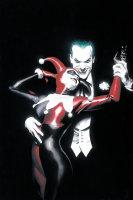  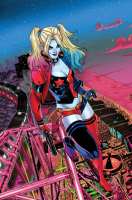
Their relationship remained in this status quo for the duration of the DCAU (as seen during the flashback scene in Batman Beyond: Return of the Joker, featuring their last time together), but things turned out differently in the mainstream DC Comics. Following her debut in Batman: Harley Quinn #1 (October 1999), where the Joker / Harley relationship was briefer and more antagonistic, the character started her comic book incarnation as the Joker's ex-girlfriend who was making her own way as a villain or, in some cases, an antihero, free of his influence. Also, thanks to a serum from Poison Ivy, she was gifted with greater acrobatic skill and an immunity to poisons. "I figured if she'd be going head-to-head with Batman and the other DC heroes, Harley would need some kind of physical edge," said Dini in Back Issue #99 (September 2017), "[…j]ust enough that if she got into a fight with say, Talia or Black Canary, she'd be able to hold her own. Wonder Woman, however, would clean her clock." Harley Quinn's presence in the DC Universe would continue, more or less, as an extension of her original character (often written by Dini himself) until 2011's New 52 event, where the character made a radical shift.
Following that reality-altering event, the world was introduced to the new Harley Quinn in Suicide Squad #1 (November 2011). Now a murderer who experienced the same dive into a chemical vat that left her with bleached skin identical to the Joker, she began her tenure in Task Force X following her stint as Joker's sidekick and lover. Also, no doubt inspired by her "sexy" attire in the Arkham series of games from Rocksteady Studios (beginning with Batman: Arkham Asylum in 2009), the new Harley Quinn ditched the jester outfit for black-and-red costumes with matching dyed pigtails that would not look out of place on a fetish model. Finally, unlike her earlier portrayal as a ditz, this incarnation showed her pre-Harley Quinn as a gifted, driven psychiatrist able to see through the Joker's mind games.
(This incarnation obviously differs from her pre- New 52, Mad Love origins, where she was portrayed as an opportunist sleeping with her professors to get the grades for her degree [leading to my head canon where Harley slept with Dr. Jonathan Crane before he became the Scarecrow]. It is worth noting that creator Paul Dini would later backtrack a bit from that characterization in his pre-52 stories, giving her moments of keen insight, such as her breakdown of Batman's mental state in Gotham City Sirens #2 [July 2009].)
Initially dark and murderous as the Joker himself—see Detective Comics, Vol. 2Harley Quinn #0 (also November 2013), where—thanks to series creators Amanda Conner and Jimmy Palmiotti—she became the antihero, Deadpool-esque, fourth-wall-breaking, LGBT+ friendly, film and animated series star that the world now recognizes her as. As of this writing she's become more and more a hero than villain, as she's closely allied with the Bat-family, and she's expected to join the Justice League during this year's Dark Crisis event.
Much like the Joker himself, adding Harley Quinn to my BTAS reboot has many hurtles, including the question of what kind of story arc to give her. Of Nightwing, the former Robin, the late Dwayne McDuffie said (on his old message boards) that "I think there's only one good Nightwing story, when he steps out from under his mentor's shadow," and I think that is also true for Harley Quinn. We may love her, but she is a one-trick pony, which is why her one good story, "leaving the Joker and becoming her own person" has been replayed over and over again for the last twenty years in the mainstream DCU (both pre- and post-New 52), the Injustice: Gods Among Us video game series (and comics), the movies—Suicide Squad (2016), Birds of Prey (and the Fantabulous Emancipation of One Harley Quinn) (2020), and The Suicide Squad (2021)—and her own self-titled animated series (2019). That would be extremely difficult to do, considering how she's never had that breakup in the DCAU (and they were a still a couple in Batman Beyond: Return of the Joker). And while it could be done here, why repeat the plot line from her own competing animated series? And, as for the alternative, it wouldn't be a BTAS reboot without her, so it would have to be something different than the standard.
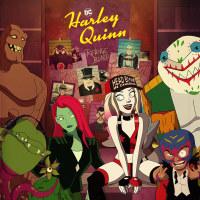 Speaking of which, there's also the fact that Arleen Sorkin, her original voice actor and originator of many of the mannerisms that made Harley Harley, retired from the character in May 2011 following the release of Batman: Arkham City. Since then, she's been voiced by Tara Strong (most of her animated appearances), Melissa Rauch (Batman and Harley Quinn [2017]), and Kaley Cuoco (Harley Quinn [2019]), as well as Margot Robbie in the DC Cinematic Universe; but while all of them are quite talented, they aren't Arleen Sorkin. It would be nice to have the originator of the character come back to make a final bow. Speaking of which, there's also the fact that Arleen Sorkin, her original voice actor and originator of many of the mannerisms that made Harley Harley, retired from the character in May 2011 following the release of Batman: Arkham City. Since then, she's been voiced by Tara Strong (most of her animated appearances), Melissa Rauch (Batman and Harley Quinn [2017]), and Kaley Cuoco (Harley Quinn [2019]), as well as Margot Robbie in the DC Cinematic Universe; but while all of them are quite talented, they aren't Arleen Sorkin. It would be nice to have the originator of the character come back to make a final bow.
Fortunately, there is a story arc available that could provide a fitting curtain call for both the DCAU's Joker and Harley Quinn; one that, surprisingly, owes quite a bit to BTAS itself.
Send in the Clowns…for the BTAS Reboot
In 2017, DC Comics published an eight-issue miniseries called Batman: White Knight, which successfully upended the traditional Batman / Joker rivalry by recasting a driven, unrelenting Batman as the villain and a non-murdering, recently medicated Joker (i.e. Jack Napier) as the hero. Written and illustrated by Sean Murphy, the story features Napier, cured of his psychosis via a new drug (secretly created by Dr. Harleen Quinzel), uses his intelligence and drive to take the GCPD to court for enabling vigilante activity in Gotham City. Following his release from prison, Jack Napier runs for city council, rekindles a more heartfelt romance with Dr. Quinzel, and—as councilman—welcomes the former street vigilantes, including Nightwing and Batgirl, into a special GCPD division run by Commissioner Gordon, allowing them to actually work with police rather than independently (and illegally).
 
Aside from the main story, the book contains other interesting details, such as the existence of the Batman Devastation Fund, a secret taxpayer fund "slipped […] inside the Natural Disaster Relief Fund—money set aside for floods and hurricanes—and hid the evidence with a private firm. Mayor Hill's old firm." This fund—which turns out to be three billion dollars annually—is used to pay for the collateral damage caused by Batman and his villains as they fight throughout the city. The series also shows how the rich game the system, as detailed by BTAS alum Pierce Chapman (from the episode "Birds of a Feather"):
I've made millions in real estate off him. Batman usually fights crime in poor neighborhoods, which the city then labels Bat Impact Zones, which drops the price of real estate even more. Those zones receive grants in order to rebuild. The trick is to buy right after a zone is declared, then flip it after the taxpayers foot the repair bill. […] Crime is the best bet in Gotham.
Finally, the series introduces a second Harley Quinn—Marian Drews, a disturbed woman who inadvertently joined up with the Joker and took her place after the original Harley left him. Angered by the reformed Napier abandoning her for the original, she became Neo Joker, a stand-in to cause chaos in Gotham City in her idol's absence. In addition to being a fascinating story—which has spawned three sequels since its publication—this series is notable for the sheer number of references to Batman: The Animated Series, from appearances by BTAS exclusive cast (the aforementioned Pierce, Veronica Vreeland, Baby Doll) to smaller references ("It was a big rock"). In fact, the most recent installment—Batman: Beyond the White Knight (2022)—introduces Batman Beyond characters Derek Powers and Terry McGinnis to the mix. It would be a shame not acknowledging this tribute by creating an adaption for the animated series that inspired it.
Of course, it would be impossible to directly adapt the plot of the story into BTAS (the DCAU Joker is a killer, of course, and do we really want to see a compromised Batman who enjoys beating up his villains and destroying his city?), I believe that the reboot can utilize some of the book's highlights to create a season-long arc.
The story would begin, perhaps in the previous season, with the Joker and a new Harley Quinn (voiced by Tara Strong), who resembles the modern version, in the midst of a typical Joker crime spree. Batman has just foiled the Joker's latest scheme and, in an offhanded way, tells him that he's losing his edge—that, for someone who values novelty and showmanship, he's now a cliché. The Joker takes this hard and, later—after escaping with Quinn—he tries to think of a new way to fight the Dark Knight. During this scene, the Joker strikes this Harley out of anger. She rubs the place she was struck, smiles, and mocks him for not hitting her harder. Here we learn that, unlike Harleen Quinzel, this Harley Quinn is a masochist who enjoys pain. As a result, the Joker doesn't hit her again. It's not funny to him.
 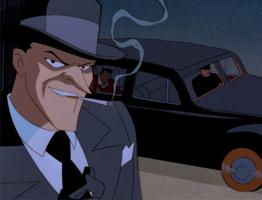 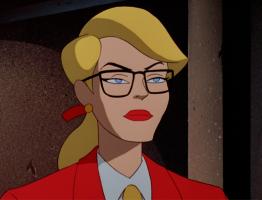
Fast forward to later, where S.T.A.R. Labs announces the development of a breakthrough in behavioral science—an implantable device that uses a combination of nanites and drugs to "reset" abnormal brain activity, allowing for the modification of emotions and control of behavior, which theoretically could provide a cure for individuals like the Joker. And the Joker is chosen to become the first test subject for the procedure.
(Here the implantable device is an alternative to the "miracle drug" that cures Joker in White Knight, and it also has the benefit of being an earlier version of the microchip that turns Tim Drake into Joker II in Return of the Joker. It also resembles the bio-technic implant used on Joker in the Spider-Man and Batman crossover [September 1995] and the real-life Stimoceiver, created by scientist José Manuel Rodriguez Delgado.)
Following the operation, upon recovering, the Joker awakens to find himself with normal skin and hair. He introduces himself as Jack Napier and, as in the miniseries, he begins fighting Batman again, only this time through the courts. And while this Batman isn't as reckless and destructive as he was depicted as in White Knight, the seemingly reformed Napier does have a point about how the police in Gotham—and, by extension, Metropolis, Central City, etc.—puts their faith in vigilantes operating outside of the law as a deterrent to crime, specifically supervillain crime.
Meanwhile, the now law-abiding Jack Napier is confronted by the second Harley Quinn and, as in the comics, is not happy that the Joker is gone. She attacks him, but is stopped by original Harley, once again voiced by Arleen Sorkin. She reveals that—following the events of "Wild Cards"—she found her way into Amanda Waller's Task Force X, served her time, and returned to psychiatry. They leave, and she pledges to help him recover.
(In the end, we learn that Dr. Quinzel was part of the S.T.A.R. Labs team that developed the implant. Her motive: intense guilt over aiding the Joker for so many years, this was an attempt to atone by "destroying" the Joker personality. However, once "cured," she slips again, falling in love with the seemingly normal man who was once her abusive boyfriend. And, as Napier, he appears to reciprocate those feelings.)
During his investigation, Napier—who occasionally finds himself experiencing nose bleeds at odd moments—discovers a conspiracy involving a faction of the GCPD and a number of Gotham's wealthy elite (we can call them The Court of Owls, if necessary). Their master plan: the periodic "escape" of supervillains from Arkham Asylum to cause chaos and, through that, drive down property values in a manner to benefit the wealthy, as mentioned above. Napier uses this victory as a means to run for city council.
 This discovery is a crushing blow to both Batman and James Gordon, who both had suspicions regarding the "revolving door" at Arkham Asylum but, until that moment, were unable to find anything aside from a few "bad apples" among the prison staff and some crooked cops. Batman, in particular, was investigating leads, but he was distracted due to "other business" (other cases, Justice League missions, etc.) and, to his credit, if the choice is investigating conspiracy to rip off taxpayers or stop an alien invasion that would destroy the planet, he had to allow some things to take priority. He's only one man. This discovery is a crushing blow to both Batman and James Gordon, who both had suspicions regarding the "revolving door" at Arkham Asylum but, until that moment, were unable to find anything aside from a few "bad apples" among the prison staff and some crooked cops. Batman, in particular, was investigating leads, but he was distracted due to "other business" (other cases, Justice League missions, etc.) and, to his credit, if the choice is investigating conspiracy to rip off taxpayers or stop an alien invasion that would destroy the planet, he had to allow some things to take priority. He's only one man.
Meanwhile, the new Harley Quinn decides—in the absence of the Joker—that someone needs to fill the void. But rather than go the Neo Joker route, perhaps the second Harley could go darker. Instead of Harley Quinn, she becomes the Harlequin—a combination of Harley and the DC villain Rag Doll….with a touch of Pennywise thrown in. She's smart, dangerous, and triple jointed, allowing her to squeeze into tight spaces and crush people to death with her body (and, if the Secret Six is introduced, she could be Rag Doll's sister—a take on Junior from Secret Six's first story arc). In her new identity, she declares war on Batman, Jack Napier, and Gotham City. As part of her plan, she detonates a bomb in Arkham Asylum, causing a massive escape, and Batman and Jack Napier must team up to stop it.
In the end, the Harlequin is defeated—I'm pulling for a Harley Quinn / Harlequin fight, sort of a symbolic battle between the original, BTAS Harley and the newer model—and, in the end, the Joker reverts. It turns out that the force of Joker's personality was too much, allowing him to overcome the implant and—more or less—control the situation incognito as himself. He pretended to be "Jack Napier" (not his real name, just an alias—this identity harkens back to some of the periods in the Batman books where he silently assumed a normal identity as part of a larger scheme) to try taking his fight with Batman to another level (and rub it in his face that he could fight crime better than him), as well as prank the city in the process. Using his "cured" persona to hurt Dr. Quinzel—giving her the love that she always craved from him, only to take it away—was icing on the cake. He says, "looks like I still have a few tricks up my sleeve, Batman." And he laughs in a drawn-out mad cackle.
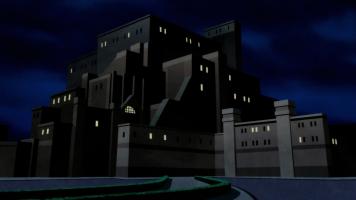
In the end, the city experiences some changes for the better—criminal charges for the conspirators, some reforms in the GCPD (while, at the same time, recognizing the need for vigilantes like Batman), and perhaps the abandonment of Arkham Asylum for a new facility (as shown in Justice League vs. The Fatal Five)—but it all comes at a cost: the recognition that these reforms came from the Joker. The Harlequin could become a new villain, perhaps for Batgirl specifically. And Harley Quinn makes a startling discovery: she's pregnant. She carries the Joker's child, and that child will eventually become the parent of Delia and Deidre Dennis—Dee Dee from Return of the Joker.
(With this in mind, it could offer an alternate reason why Harley Quinn helped the Joker kidnap Tim Drake in Return of the Joker—it was either that, or Joker would have used his own child to be the next Joker, with the microchip device that she helped create.)
* * *
So that's that. One of the benefits of this arc is that, for multiple episodes, Mark Hamill could voice the character as Jack Napier rather than Joker, allowing him a new vocal challenge with the character (as well as preventing him from straining his voice). As for the Joker's bouts of crazy laughter, I'm sure that the Warner Bros. sound department has plenty of archival audio of Hamill from the ‘90s that they could splice in. Hey, if they could use 1950 audio of Mel Blanc's voice in 2012's "Daffy's Rhapsody" cartoon I'm confident they could make it work.
Click here to discuss this editorial!
Previous installments of "The Possible Return of Batman: The Animated Series":
-Part 1: Why So Reboot?
-Part 2: Rebooting Gotham
-Part 3: The Usual Suspects
-Part 4: Bring on the Bad Guys
-Part 5: The Rogue's Gallery
-Part 6: The New Blood
Joseph Davis is a long-time contributor to the community, having run the Justice League Watchtower website and posting on WF forums under the name "Karkull" over the past 20 years.
Follow The World's Finest on
Twitter - Facebook
 |